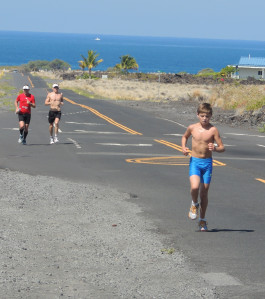“The Long Run is the Golden Key to unlocking the door (potential) to becoming a better runner!” – Alec Riddle
The one key component of developing your ability as an endurance runner, is the Long Run, so try and do 2- 4 long runs a month (experienced runners can do a midweek long run of 90 minutes). One cannot develop a decent Base, without long runs and variety is, in my opinion, the spice in a runners life, so don’t try and do the same course, at the same time, same pace, week in, week out, or your motivation may wane.
How long is a Long Run? I would say 90 minutes or longer (45-60m+ for juniors)

Doing a Long Run in Kona (Energy Lab) with Kyle Buckingham 2012. Young Jamie in the foreground doing his ‘long’ run!
How fast should a Long Run be? In the inital stages of Base Training, I think err on the side of caution and run very easy, as just running long is stressful enough. Time spent running, or Time on Legs, is more important than the quality and running too hard in the Long Run can be self destructing. As you adapt and become more comfortable running long, then you want to run closer to your Aerobic Threshold/Limit for part of the run. (or most of the run for experienced runners).
Adap-tability is important in running & in an IronMan and improving your ability to adapt to various situations can be improved, while developing your base.
I once went to a talk by Arthur Lydiard inthe early 80’s, arguably one of the greatest running coaches of all time and he said that running two hours or longer is vital. He said that you stimulate & (re) awaken dormant muscle fibers and the more muscle fibers/capilliaries you are able to recruit, the better and more improved the bloodflow, resulting in more oxygen for your muscles. (Even Peter Snell Olympic 800m Champion did 22 mile hilly runs weekly under Lydiard’s guidance)
Incorporate hills and/or trails into some of your long runs, as this will help improve all round leg strength. Do at least one of your long runs, or part thereof for inexperienced runners, say once a month at a steady pace (for IM athletes remember the marathon run in an IM is much slower than your normal training pace and it is just as important to train at this ‘slow’ pace, for specific conditioning). In my earlier days a lot of South Africa’s top distance runners, including 9 times Comrades Champion Bruce Fordyce, used to focus on ‘time on legs’ runs, whereby you just go out enjoy the run, stop for drinks and spend time on your legs. I used to enjoy those runs immensely.
At the same time we don’t always want to run slowly (the plods), so when doing an easy long run, incorporate 2-3 ‘steady’ sections into the run. Example when running a Long Run run mostly @ an easy pace, do 20 minutes at a slightly faster pace (not too hard simply a little faster), recover for a km or two and repeat 2-3 times depending on your level of fitness, finishing off at your easy pace.
One of the biggest mistakes made by ultra runners/triathletes is believing that they will lose endurance if they don’t run long regularly in the build up to their key race. DO NOT do Long Runs (longer than 90 minutes) within 3 weeks of your target race, as you may find your legs won’t recover sufficiently in time.
Additional benefits of the Long Run:
The Long Run builds both muscular strength and fitness. If your body is not strong you can push your body too hard, leading to injury. The Long Run strengthens the joints, ligaments & muscles.
The Long Run helps prevent injuries, as it provides a foundation that enables you to do faster work as you build to your key race. Think of a building, the bigger the fundation, the higher the peak.
The Long Run importantly assists the body in the utilization of energy sources. Most people try and run too hard and burn Carbohydrates (or Glycogen) which is very inefficient. Running long (and slower) enhances your ability to burn fatty acids as an energy source, thus sparing the more limited carb stores.
Ironman Tip/s: We will talk more about specificity in a later Tip, but I would suggest running the odd long run, after a medium bike ride, as this will assist you to ‘slow’ down.
I thoroughly enjoy reverse bricks to improve running endurance (and reduce the chance of injury) and have found these to work very well for me. This involves running first and following up with a decent bike ride. For me, this is a common 3 hour workout, where I would run 90 min and then bike 90 minutes. This was a tip I picked up in Korea from Brendon Downey of endurancecoach.com, coach of many world class Triathletes.
Illustrating the importance of building a Base in the link below…..
http://ironmansa.com/2014/04/14/the-bigger-the-base-the-higher-the-peak/






